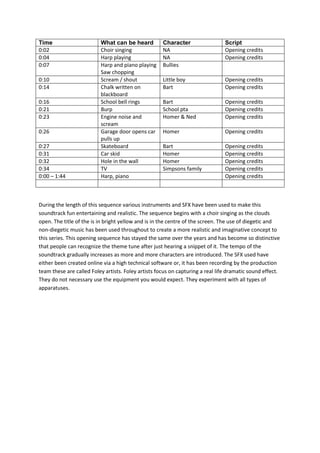Simpsons analysis
- 1. Time What can be heard Character Script 0:02 Choir singing NA Opening credits 0:04 Harp playing NA Opening credits 0:07 Harp and piano playing Saw chopping Bullies 0:10 Scream / shout Little boy Opening credits 0:14 Chalk written on blackboard Bart Opening credits 0:16 School bell rings Bart Opening credits 0:21 Burp School pta Opening credits 0:23 Engine noise and scream Homer & Ned Opening credits 0:26 Garage door opens car pulls up Homer Opening credits 0:27 Skateboard Bart Opening credits 0:31 Car skid Homer Opening credits 0:32 Hole in the wall Homer Opening credits 0:34 TV Simpsons family Opening credits 0:00 â 1:44 Harp, piano Opening credits During the length of this sequence various instruments and SFX have been used to make this soundtrack fun entertaining and realistic. The sequence begins with a choir singing as the clouds open. The title of the is in bright yellow and is in the centre of the screen. The use of diegetic and non-diegetic music has been used throughout to create a more realistic and imaginative concept to this series. This opening sequence has stayed the same over the years and has become so distinctive that people can recognize the theme tune after just hearing a snippet of it. The tempo of the soundtrack gradually increases as more and more characters are introduced. The SFX used have either been created online via a high technical software or, it has been recording by the production team these are called Foley artists. Foley artists focus on capturing a real life dramatic sound effect. They do not necessary use the equipment you would expect. They experiment with all types of apparatuses.
